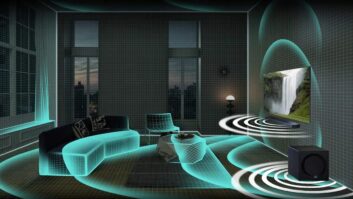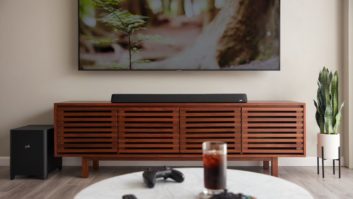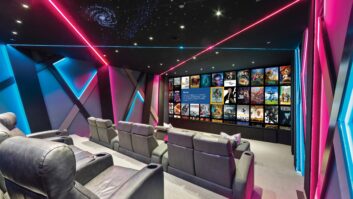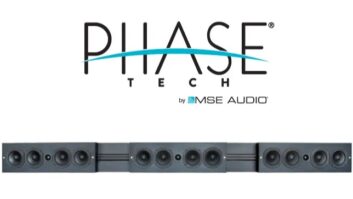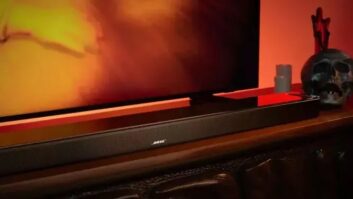Soundbar demand is still on the rise, having broadened their appeal by morphing from TV-sound accessories into full-fledged audio systems with Bluetooth, HDMI switching, and Wi-Fi multiroom audio.
As household penetration has risen, however, unit growth has slowed, and declining average selling prices have helped drive down dollar growth even more, analysts say.
With growth still in the forecast, however, dealers will find more soundbar choices at CES, where Klipsch will greatly expanding its selection and Riva will show its first models.
Dealers will also find a growing selection of soundbars equipped with wireless multiroom-audio technology, more soundbars with HDMI inputs and outputs, and at least one more soundbar equipped with Dolby Atmos object-based surround decoding. It’s from Samsung, joining Yamaha in the market. More Atmos-equipped sound bars are expected this year.
Because of their broadening appeal as audio systems, and because they’re simpler to set up than hometheater- in-a-box (HTiB) systems, household penetration of soundbars exceeded 16 percent at the end of 2015, including under-TV speaker bases, Future Source said. That will grow by another 5 percentage points in 2016 as consumers continue to desert home theater-in-a-box systems “in favor of this simpler solution,” the company explained.
U.S. shipments of soundbars and under-TV speaker bases rose in units by a robust 49 percent in 2014 but slowed to a forecast 18 percent in 2015 and will slow to 13 percent in 2016, Future Source also said. Retail-level dollar growth is falling faster, shifting from a 40-percent gain in 2014 to a forecast 12.5 percent in 2015 and 6 percent in 2016.
For its part, The NPD Group found retail-level dollar growth of 13 percent to $885.6 million for the 12 months ending October 2015, down from the year-ago 34 percent gain. For the January-October 2015 period, sales rose 10 percent to $564.3 million.
In units for the 12 months ending October, sales were up 17 percent to 4.3 million, down from the year-ago 37 percent. For the January-October period, unit sales were up 12 percent to 2.4 million.
With continued albeit slower growth on the way, suppliers are bringing a wide range of new models to CES. Here’s what some suppliers plan:
LG: The company is launching five new soundbars, three of which incorporate Music Flow Wi-Fi mesh-network multiroom-audio technology. One will be LG’s first soundbar with HDMI 2.0 input and its first with HDCP 2.2 4K copy protection.
The company will also carry over two of four multiroom- audio soundbars from 2015.
Two other new soundbars also debut, though only with Bluetooth and not with Wi-Fi or multiroom audio.
No new Blu-ray-equipped HTiBs will be introduced as that market shrinks, but four will be carried over. The company isn’t launching new under-TV Sound Plates.
All three of the new Music Flow bars feature a simpler method to connect wirelessly to tabletop Music Flow Wi-Fi speakers to create a 5.1-channel home theater speaker system. The new soundbars offer one-button setup to connect automatically to a pair of LG Wi-Fi speakers that can be used as left-right surround speakers.
These bars also add adaptive sound control, which detects the type of audio content coming in and automatically changes to the proper preset EQ, such as music or dialog.
The new Music Flow bars are the SH6 with built-in passive radiators and no outboard subwoofer, the 360- watt SH7 with outboard sub, and the 420-watt SH8 with outboard sub. All feature HDMI input and output, but the SH8 steps up to HDMI 2.0 with HDCP 2.2 copy protection.
The two carryover models with Wi-Fi and Music Flow are the curved 360-watt LAS855M, which retailed at $699 last year, and the top-end 700-watt LAS950M with 192/24 DAC and a $999 price point. They also feature HDMI input and output.
The two new soundbars without Wi-Fi or Music Flow are the 100-watt SH2 with wired subwoofer and 320- watt SH5, both with Bluetooth.
Pricing and additional details of the new models were unavailable
Morel: A passive in-wall soundbar, due this month, features a modular design so it can be configured as a two-channel or threechannel model and stretched up to 63 inches for use with many sizes of TVs. The SoundWall LCR 4, due this month, uses shallow 4-inch driver modules so it can be retrofitted in existing walls with no modification to the internal wall structure and without complex installation techniques, the company said.
One module features a time-aligned woofer and tweeter with woofer motor structure that combines neodymium and ferrite magnets and a 2.1-inch external aluminum voice coil. Another module is a subwoofer module with 4-inch driver.
Riva Audio: The brand, marketed by Audio Design Experts, planned to show concept prototypes of the first Rivabrand soundbars and wireless multiroom- audio speakers.
Spectra Merchandising Int.: A new soundbar under the licensed Jensen brand is the $149-suggested 2.1-channel Jensen JSBW-750 with Bluetooth. It features optical and coaxial input jacks, RCA analog input jack, remote control, and a 1-ampere USB port for charging your smartphone. The wall-mountable bar comes with preset audio modes.
ZVOX: The company is coming to CES with its first soundbars in years to complement its under-TV speaker bases.
Two models, priced at $599 and $499, ship in the first quarter with 3.2-inch-deep extruded-aluminum cabinets to maximize interior volume. They also use a computer-controlled woofer system, called MegaBass, to fine-tune the excursion of 4-inch long-throw woofers to deliver accurate bass down to 42Hz in one model without an external subwoofer. Both are positioned as the first-ever slender sound bars that don’t require an external subwoofer for bass.
The two models carry over the speaker bases’ proprietary AccuVoice dialog enhancement feature, which uses hearing- aid technology to deliver clear voice reproduction. The feature is said to be particularly appealing to Americans with have some degree of hearing impairment.
Other features include PhaseCue virtual surround sound, Dolby Digital processing, aptX Bluetooth wireless streaming, and ZVOX’s output leveling.





